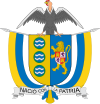Aguadas, Caldas
| Aguadas, Caldas | |||
|---|---|---|---|
| Municipality and town | |||
|
|||
 Location of the municipality and town of Aguadas, Caldas in the Caldas Department of Colombia. |
|||
| Location in Colombia | |||
| Coordinates: 5°37′0″N 75°28′0″W / 5.61667°N 75.46667°W | |||
| Country |
|
||
| Department |
|
||
| • Density | 43,74/km2 (11,330/sq mi) | ||
| Time zone | Colombia Standard Time (UTC-5) | ||
Aguadas is a town and municipality in the Colombian Department of Caldas. It is bounded on the north by Abejorral, on the east by Sonsón, Salamina in the southeast, on the south by Pacora, on the west with Caramanta and Valparaiso, and the northwest with La Pintada. The municipality of Aguadas was founded in 1808 by José Narciso Estrada. It is located in the northern part of the department. In addition to the fame of Aguadeño Hats (Sombrero aguadeño in Spanish), which are very similar to the Panama Hat made of palm straw called iraca in Colombia. Aguadas offers visitors its historic center, declared a National Monument in 1982. It has a temperate climate thanks to the variety of climates ranging from warm to moor.
Another of its main attractions is the National Festival of the Colombian Pasillo (In Spanish, Festival Nacional del Pasillo Colombiano), an annual event that has earned recognition for Aguadas as the capital of the Colombian Pasillo.
It was the Coucuyes Indians who inhabited the land now called Aguadas when the conquistadors arrived. These Indians were baptized with the name of Armados (Spanish for armed) apparently based on the outfits they wore.
Marshal Jorge Robledo was one of the first Spaniards to visit these lands. Sebastian de Belalcazar, his commanding officer, had ordered him to found a town as a military fort named Santiago de Arma (1542). Gold deposits were found in the area which attracted many families. The subsequent depletion of the ore led to the abandonment of the region, and finally the authorities ordered the transfer of Arma to the town of Rionegro. However, many villagers refused to leave the village, and in 1808 decided to found Aguadas in response to the massive influx of settlers from Antioquia.
...
Wikipedia



